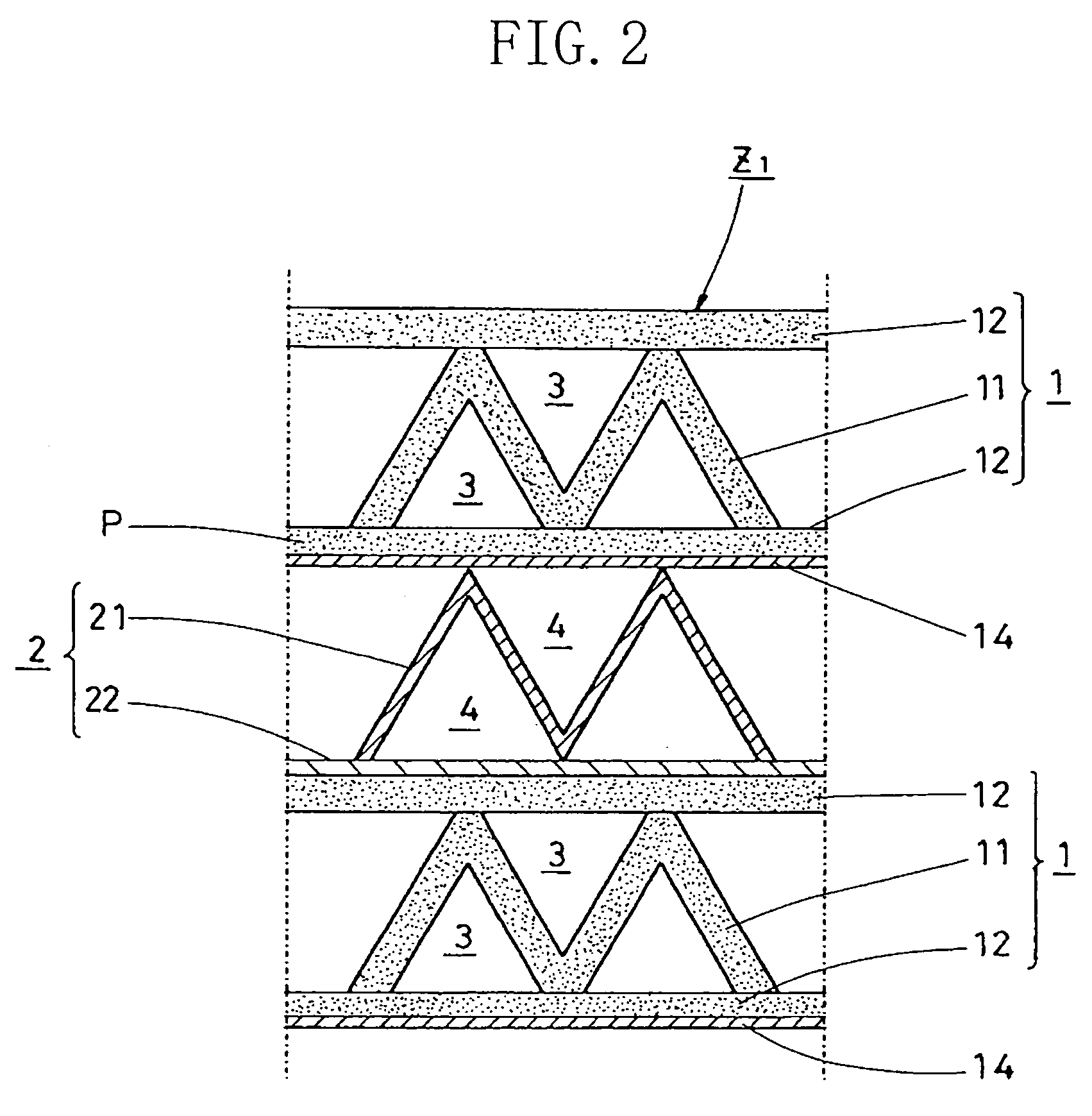Dehumidifying element, and adsorbing element used for the dehumidifying element
a technology of dehumidification element and adsorption element, which is applied in the field of dehumidification units, can solve the problems of affecting the dehumidification capability of the dehumidification unit, and achieve the effects of improving the performance of heat transfer between the air ventilation passages 3, 4 and cost saving
- Summary
- Abstract
- Description
- Claims
- Application Information
AI Technical Summary
Benefits of technology
Problems solved by technology
Method used
Image
Examples
embodiment 1
I. Embodiment 1
[0069] Referring to FIGS. 1-3, there is illustrated a dehumidification unit Z1 formed in accordance with a first embodiment of the present invention. The dehumidification unit Z1 is the result of the application of inventions as set forth in claim 1, claim 2, claim 5, and claim 8. As shown in FIG. 1, the dehumidification unit Z1 is formed in the following way. A plurality of adsorption elements 1, 1, . . . and a plurality of cooling elements 2, 2, . . . are laminated sequentially alternately in a 90-degree plane phase. Then, such a laminated body is provided, at its both ends relative to the lamination direction, with end plates 9, 9, as shown in FIG. 3. Two end plates 9, 9 are connected together by four frame members 10, 10, . . . which are arranged along the four corners of the laminated body, whereby these components are combined into a single piece. Hereinafter, specific constructions for the adsorption element 1 and the cooling element 2 will be described.
[0070]...
embodiment 2
II. Embodiment 2
[0086] Referring to FIGS. 4 and 5, there is illustrated a dehumidification unit Z2 formed in accordance with a second embodiment of the present invention. The dehumidification unit Z2 is the result of the application of inventions as set forth in claim 1, claim 2, claim 3, claim 5, and claim 8. As can be seen from FIG. 4, the dehumidification unit Z2 is formed by sequentially alternately laminating a plurality of adsorption elements 1, 1, . . . and a plurality of cooling elements 2, 2, . . . one upon the other in a 90-degree plane phase. The dehumidification unit Z2 of the present embodiment is identical in basic construction with the dehumidification unit Z1 of the first embodiment, with the exception that the adsorption element 1 of the dehumidification unit Z2 differs in construction from the adsorption element 1 of the dehumidification unit Z1.
[0087] To sum up, in the adsorption element 1 of the dehumidification unit Z1 according to the first embodiment, the sid...
embodiment 3
III. Embodiment 3
[0092] Referring to FIGS. 6 and 7, there is illustrated a dehumidification unit Z3 formed in accordance with a third embodiment of the present invention. The dehumidification unit Z3 is the result of the application of inventions as set forth in claim 1, claim 2, claim 5, and claim 8. As shown in FIG. 6, the dehumidification unit Z3 is formed by sequentially alternately laminating a plurality of adsorption elements 1, 1, . . . and a plurality of cooling elements 2, 2, . . . one upon the other in a 90-degree plane phase. The dehumidification unit Z3 of the present embodiment is identical in basic construction with the dehumidification unit Z1 of the first embodiment, with the exception that they differ from each other in construction of the adsorption element 1 as well as in construction of the cooling element 2.
[0093] The adsorption element's construction difference is pointed out. For the case of the adsorption element 1 of the dehumidification unit Z1 according t...
PUM
| Property | Measurement | Unit |
|---|---|---|
| Thickness | aaaaa | aaaaa |
| Electrical resistance | aaaaa | aaaaa |
| Height | aaaaa | aaaaa |
Abstract
Description
Claims
Application Information
 Login to View More
Login to View More - R&D
- Intellectual Property
- Life Sciences
- Materials
- Tech Scout
- Unparalleled Data Quality
- Higher Quality Content
- 60% Fewer Hallucinations
Browse by: Latest US Patents, China's latest patents, Technical Efficacy Thesaurus, Application Domain, Technology Topic, Popular Technical Reports.
© 2025 PatSnap. All rights reserved.Legal|Privacy policy|Modern Slavery Act Transparency Statement|Sitemap|About US| Contact US: help@patsnap.com



